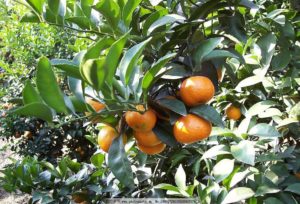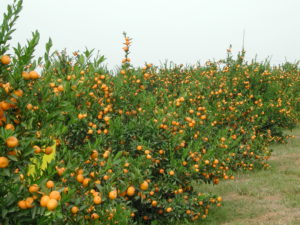Scientific Fertilization Technology of Citrus
As the spring come, the temperature rise rapidly and the crops with fast nutrition growth also needs more and more fertilizer and water to ensure growth. According to the study, there should be nitrogen 6 kg, phosphorus 1.1kg, potassium 4 kg, calcium 0.8 kg, magnesium 0.27 kg every time when you want the citrus production reach to 1000 kilograms. In addition,
 the ratio of nitrogen, phosphorus and potassium should be 1: 0.2: 0.7.
the ratio of nitrogen, phosphorus and potassium should be 1: 0.2: 0.7.
The nutrient absorption of citrus varies with the seasons. As for new branches, the absorption of phosphorus begin from the beginning of summer, to the late summer and early autumn. The absorption of nitrogen and potassium began to increase from mid-summer and the highest absorption peak appeared in August-September.
Spring citrus are beginning to leaves will need lot of nitrogen fertilizer so that we should apply 10-15 kg per acre. In addition, we should reduce the amount of nitrogen fertilizer application in some places where have high temperature or good for citrus growth. Otherwise, the roots will be burned. Spring fertilization should pay special attention to the absorb roots protection of fruit trees (can not hurt the roots). The best way of fertilization is multi-point, and the depth should be 25-30 cm which can make the roots reach the fertilizer so that improve the fertilizer efficiency and utilization.
In addition to topdressing fertilizers like nitrogen, phosphorus and potassium fertilizer, foliar fertilization also is important. Spring is the season when citrus will have fruit. The soil lacks of boron will have bad influence on its fruit growth because boron fertilizer can promote cell division, elongation, regulation of water, to promote crop pollen fertilization, flowering and solid irreplaceable. Therefore, before and during the flowering seasoning applying boron fertilizer is essential. Generally in the citrus flowering or flowering period, spraying boron with water 1500-200 times can prevent the occurrence of falling fruit and “thick fruit.”
For the relatively barren soil, there often will be the phenomenon of production drop because of lack of trace elements. In spring, citrus need a lot of nutrients and amount of trace elements, so we can apply the “Ou Shen” potassium nitrate foliar fertilizer and “Ou Shen” Euro multi-chelating micro-fertilizer which can not only satisfy the need for nitrogen and potassium of citrus leaves, but also add a variety of trace elements to it. For areas lack of calcium, especially in areas where fruit cracking occurred in previous years, we should pay attention to add calcium fertilizer.
there often will be the phenomenon of production drop because of lack of trace elements. In spring, citrus need a lot of nutrients and amount of trace elements, so we can apply the “Ou Shen” potassium nitrate foliar fertilizer and “Ou Shen” Euro multi-chelating micro-fertilizer which can not only satisfy the need for nitrogen and potassium of citrus leaves, but also add a variety of trace elements to it. For areas lack of calcium, especially in areas where fruit cracking occurred in previous years, we should pay attention to add calcium fertilizer.
In general, the most suitable temperature for foliar fertilizer is 18-25 ℃. Humidity: the higher the better. Spray time: the best time for spraying is before 10 am and after 4 pm, because in this time, the solution can quickly concentrated which affect both the absorption and the injury of solution. The stoma on the front leaves are more than the stoma on the back leaves. Therefore, we should spray the fertilizer on the back of leaves to promote fertilizer absorption.
This article quoted from: http://www.uuuu.cc/zl/nongye/2012/0503/19316.html
Previous: Chinese Rose to flowering
